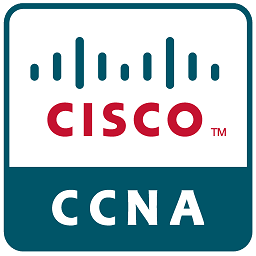CCNA
CCNA course covers networking fundamentals, LAN, routing, infrastructure services, and device configuration/troubleshooting, preparing for certification. Enhances network management skills and understanding of network operations.


duration
50 null

NEXT BATCH
__

mode

payment options

Program Overview
Master networking essentials with CCNA course. Learn protocols, routing, security, and Cisco technologies. Gain certification readiness and advance your networking career.

Gain foundational knowledge in networking

Learn to install, configure, operate, and troubleshoot network systems.

Improve employability with a globally recognized certification.

Develop skills applicable to a wide range of IT disciplines.
Eligiblility
Why should you learn?
Possible Job Roles
Salary Range
Course Modules
50 null COURSE
Network Fundamentals
+Routers
Layer 2 and Layer 3 switches
Next-generation firewalls and IPS
Access points
Controllers (Cisco DNA Center and WLC)
Endpoints
Servers
PoE
Describe characteristics of network topology architectures
+Two-tier
Three-tier
Spine-lea
WAN
Small office/home office (SOHO)
On-premise and cloud
Compare physical interface and cabling types
+Single-mode fiber, multimode fiber, copper
Connections (Ethernet shared media and point-to-point)
Identify interface and cable issues (collisions, errors, mismatch duplex, and/or speed)
Compare TCP to UDP
Configure and verify IPv4 addressing and subnetting
Describe the need for private IPv4 addressing
Configure and verify IPv6 addressing and prefix
Describe IPv6 address types
+Unicast (global, unique local, and link local)
Anycast
Multicast
Modified EUI 64
Verify IP parameters for Client OS (Windows, Mac OS, Linux)
Describe wireless principles
+Nonoverlapping Wi-Fi channels
SSID
RF
Encryption
Explain virtualization fundamentals
+Server Virtualization
Containers and VRFs
Describe switching concepts
+MAC learning and aging
Frame switching
Frame flooding
MAC address table
Network Access
+Configure and verify VLANs (normal range) spanning multiple switches
Access ports (data and voice)
Default VLAN
Connectivity
Configure and verify interswitch connectivity
Trunk ports
802.1Q
Native VLAN
Configure and verify Layer 2 discovery protocols (Cisco Discovery Protocol and LLDP)
Configure and verify (Layer 2/Layer 3) EtherChannel (LACP)
Interpret basic operations of Rapid PVST+ Spanning Tree Protocol
Root port, root bridge (primary/secondary), and other port names
Port states (forwarding/blocking)
PortFast
Describe Cisco Wireless Architectures and AP modes
Describe physical infrastructure connections of WLAN components (AP, WLC, access/trunk ports, and LAG)
Describe AP and WLC management access connections (Telnet, SSH, HTTP, HTTPS, console, and TACACS+/RADIUS)
Interpret the wireless LAN GUI configuration for client connectivity, such as WLAN creation, security settings, QoS profiles, and advanced settings
IP Connectivity
+Interpret the components of routing table
Routing protocol code
Prefix
Network mask
Next hop
Administrative distance
Metric
Gateway of last resort
Determine how a router makes a forwarding decision by default
Longest prefix match
Administrative distance
Routing protocol metric
Configure and verify IPv4 and IPv6 static routing
Default route
Network route
Host route
Floating static
Configure and verify single area OSPFv2
Neighbor adjacencies
Point-to-point
Broadcast (DR/BDR selection)
Router ID
Describe the purpose, functions, and concepts of first hop redundancy protocols
IP Services
+Configure and verify inside source NAT using static and pools
Configure and verify NTP operating in a client and server mode
Explain the role of DHCP and DNS within the network
Explain the function of SNMP in network operations
Describe the use of syslog features including facilities and levels
Configure and verify DHCP client and relay
Explain the forwarding per-hop behavior (PHB) for QoS, such as classification, marking, queuing, congestion, policing, and shaping
Describe the capabilities and function of TFTP/FTP in the network
Security Fundamentals
+Define key security concepts (threats, vulnerabilities, exploits, and mitigation techniques)
Describe security program elements (user awareness, training and physical access control))
Configure and verify device access control using local passwords
Describe security password policies elements, such as management, complexity, and password alternatives (multifactor authentication, certificates, and biometrics)
Describe IPsec remote access and site-to-site VPNs
Configure and verify access control lists
Configure and verify Layer 2 security features (DHCP snooping, dynamic ARP inspection and port security
Compare authentication, authorization, and accounting concepts
Describe wireless security protocols (WPA, WPA2, and WPA3)
Configure and verify WLAN within the GUI using WPA2 PSK
Automation and Programmability
+Explain how automation impacts network management
Compare traditional networks with controller-based networking
Describe controller-based, software defined architecture (overlay,underlay and fabric)
Separation of control plane and data plane
Northbound and Southbound APIs
Compare traditional campus device management with Cisco DNA Center enabled device management
Describe characteristics of REST-based APIs (CRUD, HTTP verbs, and data encoding)
Recognize the capabilities of configuration management mechanisms Puppet,Chef, and Ansible
Recognize components of JSON-encoded data
Cisco Certified Network Associate
Certifies completion of CCNA course, including network installation, configuration, troubleshooting, LAN switching, and routing

Admission Process at Cokonet
The course admission process at Cokonet involves streamlined procedures ensuring efficient enrollment for prospective students.
 Step 1
Step 1Speak With our Career Counselor
Our career counselor will help you identify the suitable course for you.
 Step 2
Step 2Complete Payment
Finalize the transaction securely, using the provided payment methods.
 Step 3
Step 3Get Enrolled
Enroll in the chosen course, providing personal details and payment information.

Dhaynchand
AI/ML Engineer

Companies that our Alumni work in
Join Cokonet
Identify your suitable courses in a few clicks
Find from a list of 60+ courses to launch your career.
corporates
Looking to enroll your employees into this program?
Our Hire-Train-Transfer model revolutionises corporate talent acquisition by seamlessly connecting businesses with skilled professionals through customised training programs.
Know moreOur Corporate Training Services, delivered by industry experts, equip employees with the latest skills and certifications, enabling them to meet project demands and excel in cutting-edge domains.
Know moreCokonet's upcoming job portal, SurePool.in, provides top-notch staffing services, connecting businesses with qualified professionals for seamless workforce augmentation.
Know more
Financing & Support

0% Interest Loans
Access 0% interest loans (6/9/12 Months EMI) for your education, ensuring affordability while you pursue your dreams.

Pay in Installments
Ease your financial burden with our convenient installment payment options.

Scholarships
We believe in supporting aspiring learners by providing financial aid to help them pursue their dreams.

Laptop Support
Seamless assistance with our comprehensive laptop support services.






